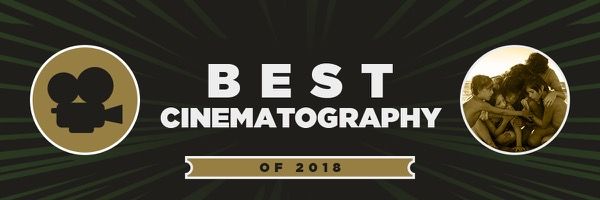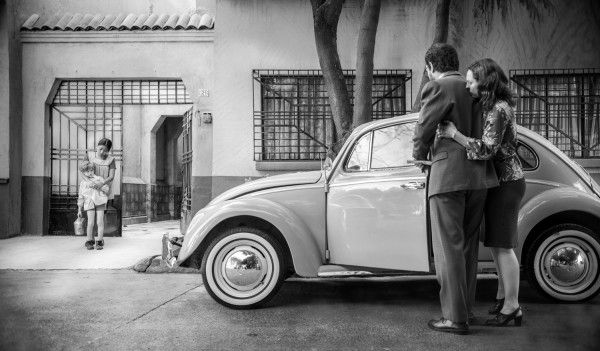2018 has been a great year for movies, but in the glut of all the year-end listmaking, it feels as though the actual craft of filmmaking can get a bit lost in the discussion. Which is why putting together a list of the best cinematography of the year is one of my annual highlights, and certainly 2018 was not lacking for noteworthy visuals. From gorgeous to haunting to groundbreaking, the year in cinematography runs the gamut as various directors of photography worked hard to not only craft pleasing or gorgeous visuals, but to serve the story and characters through shot composition and visual metaphor.
So behold, the best cinematography of 2018.
10. A Quiet Place – Charlotte Bruus Christensen
2018 was not just a great year for horror, it was also a great year for horror craftsmanship. As a film with very little verbal dialogue, John Krasinski’s A Quiet Place leaned heavily on visual storytelling, and cinematographer Charlotte Bruus Christensen brings a haunting, confident approach to the entire proceeding. The shot composition is exquisite and the film is packed with iconography (that bathtub scene!), but I was particularly taken with Christensen’s use of light. The film’s story mostly takes place over the course of 24 hours or so, and the subtle changes in light are gorgeously captured, leading to some really dynamic nighttime work involving red Christmas lights.
9. Widows – Sean Bobbitt
Widows is a very different kind of film for director Steve McQueen, and yet his carefully considered shot composition and movement with longtime cinematographer Sean Bobbitt remains intact in what amounts to their first popcorn movie. Every frame is dripping with meaning, and as McQueen places his characters in specific positions within the space, Bobbitt frames it all up so the metaphor is potent. And of course it wouldn’t be a McQueen/Bobbitt joint without a couple of long takes, and here we get one of the most striking of their career, as Bobbitt mounts the camera on the hood of Colin Farrell’s car and the wealth disparity within mere blocks of Chicago becomes abundantly clear.
8. Suspiria – Sayombhu Mukdeeprom
For Call Me by Your Name, director Luca Guadagnino and cinematographer Sayombhu Mukdeeprom really trafficked in bright light and colors. So imagine our surprise when their horror remake Suspiria turned out to be lacking in bright color. Of course, this was by design. Guadagnino’s take on Suspiria is very much a story about fascism, and so the film is covered in brutalistic and cold colors until it absolutely explodes in a violent kaleidoscopic finale, which is all the more effective given the color restraint inflicted upon the audience for the previous two hours. The camera placement throughout the film is inspired, and Mukdeeprom really digs deep to result in an unnerving, sneakily shocking experience for the viewer. This is subtlety at its best.
7. First Man – Linus Sandgren
I’ll admit, on first blush I wasn’t too taken with the cinematographic choices in First Man. Director Damien Chazelle’s chronicle of Neil Armstrong’s trip to the moon is told in intimate fashion, with the camera never really leaving the personal space of its subjects. That can sometimes feel claustrophobic or dizzying even, but then that’s the point. This is what these men endured to make this superhuman journey, armed with only their minds and decision-making skills. But it’s Linus Sandgren’s sumptuous 16mm photography that turned me around on a second watch, as the cinema verite approach brings Armstrong and his family to life in a strikingly realistic detail. The colors pop off the screen; this feels like film. And that’s all before we get to the jaw-dropping (and aspect ratio-shifting) IMAX photography on the moon.
6. Cold War – Łukasz Żal
Five years ago, cinematographer Łukasz Żal earned high praise and an Oscar nomination for shooting director Pawel Pawlikowski’s terrific Ida in stunning black and white. Now he’s reteamed with Pawlikowski for another black-and-white film, but with a very different approach. Cold War is presented once again in 4:3 ratio and in B&W, but its approach is more chaotic and free-flowing, underlining the hot-and-cold romance at the center of the story. Żal frames it up beautifully, capturing the early days of the Cold War in Eastern Europe and Paris. The handheld photography is a heartbreaking sight to behold.
5. Mission: Impossible – Fallout – Rob Hardy
When Christopher McQuarrie agreed to be the only Mission: Impossible director to return and helm a second film in the franchise, he did so on the condition that Mission: Impossible – Fallout feel like it was made by a different director. To that end, he enlisted Rob Hardy to shoot the film, and holy hell what an inspired choice it turned out to be. This is at once the most intimate and most epic film in the franchise, and Hardy’s alluring, unmistakably cinematic cinematography reflects that dynamic. Playing with light, some scenes almost feel dreamlike as they evoke a warm haze. Then, thankfully, this cinematic quality is not lost when it comes to the jaw-dropping action, which is shot with a focused vitality that keeps the stakes high but never forsakes clarity of motion. That Hardy was able to make a bathroom brawl, sky diving stunt, and helicopter chase all feel cinematic and a piece of a whole would be enough to warrant consideration for this list, but it’s the extra attention to detail in the quiet, character-centric scenes that makes it a Top 5 contender.
4. The Favourite – Robbie Ryan
Boy, what a choice those fish eye lenses were huh? Yorgos Lanthimos’ hilariously acidic The Favourite is shot with a very specific style, but it’s all in service of the story being told. Robbie Ryan’s cinematography reinforces the ironic claustrophobia the characters endure within Queen Anne’s mansion, both physical and metaphorical. There is no escape. From each other, from Parliament, from your own sadness and despair. It’s unavoidable, and thus Ryan’s camera makes the various (and gutting) twists and turns that much more effective as the audience feels the palpable tension throughout. Oh and there’s also the fact that much of the film is shot with natural light and candlesticks and it is gorgeous. So yeah, this one’s a looker.
3. A Star Is Born – Matthew Libatique
Cinematography is not simply about making something look appealing; it’s also about telling a story with the camera. Matthew Libatique’s cinematography in A Star Is Born is packed with visual symbolism and motivated shot composition (on top of a ton of iconography), all in service of the tragic love story at the heart of the film. Working hand in hand with director Bradley Cooper, Libatique captures the lives of Jackson and Ally with a vibrant intimacy that never forsakes the characters as humans. Even when chronicling the musical performances, the camera remains on the characters’ faces, maintaining the emotional resonance all the way up through the film’s gut-punch of an ending. This is controlled, precise filmmaking operating on a grand scale, and Libatique nails it.
2. If Beale Street Could Talk – James Laxton
James Laxton already wowed us once with his cool, crisp touch on Moonlight, but he does it again (yet completely differently) for If Beale Street Could Talk. Director Barry Jenkins’ James Baldwin adaptation is, at heart, a romance, and Laxton’s warm, rich cinematography will make you believe in love. But it’s also a film about racism, wrongful imprisonment, and the complexities of family—indeed, how the love between the two central characters attempts to survive through these various hardships is very much the film’s throughline. So Laxton’s velvety cinematography exudes this warmth in stunning detail, but is also tremendously effective in capturing the melancholy that’s laced throughout this story.
1. ROMA – Alfonso Cuarón
The best cinematography of 2018 comes from a director, of all places. But Alfonso Cuarón is not just any director. He’s been pushing the boundaries of cinema for his entire career, and honing his craft alongside master cinematographer Emmanuel Lubezki provided him with the tools necessary to take the reigns himself on ROMA when Lubezki became unavailable. Every choice made when it comes to the visual presentation of ROMA is surprising, and yet each piece works together to serve a whole that is, in a word, masterful. Cuarón chose black and white to evoke the past, but shot on the pristine Alexa 65 digital camera to offer up a crisp and clear image with a strong depth of field.
As for the camera movement, Cuarón opts for slow pans rather than zooms or tacking shots. The result is a wholly objective and nearly voyeuristic viewing experience. You watch as Cuarón bares his soul, viewing from afar as an objective observer. The family at the center of ROMA crumbles before your eyes, but the cinematography reinforces the idea that you can do nothing about it. You’re looking into the past, helpless, able to offer up only your empathy. It’s a stunning, groundbreaking cinematic achievement full-stop, and one that could only have come from the mind, body, and soul of Cuarón himself.
Honorable Mentions: Hereditary, The Ballad of Buster Scruggs, Annihilation, Bad Times at the El Royale, Can You Ever Forgive Me?, Black Panther


